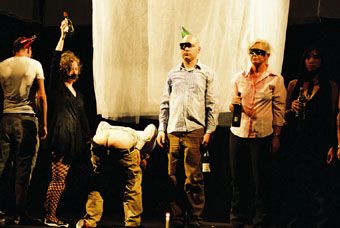 |
version 1.0 photo: Heidrun Löhr |
On the night of the big party, Alan Schacher’s attempt to reproduce a performative installation over the entrance to PS led to his removal by the police after a passerby thought he might be suicidal. The Sydney Front temporarily re-formed to persuade a sizeable chunk of the audience to either slip into petticoats or take off their clothes altogether and to dance with each other to the Fascination Waltz. There was no shortage of takers. Version 1.0 showing continued commitment to boozing their way through the current political depression, at least performatively, bared an arse to a rapped-up version of John Howard’s victory speech. Not subtle, but it wasn’t that kind of night.
Performance Space Patron Robyn Archer kicked off the celebrations over the birthday cake a few days before, urging debate and commitment amidst the gloom arising from the Howard election victory and Bush’s imminent defeat of John Kerry. Approving of Mark Latham’s stance on a woman’s right to control her own body when it came to abortion, she despaired at the same politician’s opposition to gay marriage: “Whether I wish to be or not, I am now an outlaw because of my sexual preference.” Archer argued the urgent need for alternative voices to be heard, emphasising Performance Space’s role in this and in its “support for local artists, but also in presenting a very special interface between the local and the international.”
The well-deserved and wildly applauded awards to Performance Space Legends (what next, PS Idol?) presented at the cocktail party in the form of plaques and framed photographs of classic performances went to performer Nigel Kellaway, architect and long-term Board member Brian Zulaikha, dance critic Jill Sykes, photographer Heidrun Löhr and founding artistic director Mike Mullins.
The one-day symposium, Performance Space: Politics & Culture, held at Museum of Sydney, proved fertile ground for what should be an ongoing discussion about the place of Performance Space in Sydney and in Australian culture and a serious opportunity to discuss its future as it nears the move to the Eveleigh Carriageworks in Redfern. From the symposium we’ve reproduced Julie-Anne Long’s personal reflection on Performance Space as building and community, specifically in its relationship with dance. Ian Maxwell, in a polemical mood, looks at the various ways Performance Space was described in the course of the symposium and the degrees to which those representations were inadequate. Hopefully Ian’s argument will provoke the debate we are all eager for. As Anthony Steel argued in his keynote address, “Very seldom do governments and funding bodies talk about the arts in philosophical terms, and it is that debate that is so urgently needed.”
Performance Space’s 21st birthday celebrations were best of all an intensely communal event, a huge gathering of former artistic directors, managers and other staff, board members, supporters, arts bureaucrats, and the many artists who have performed in that eternally transformable building. Performance Space has engendered and supported an enormous amount of work over its 2 decades and is part of a larger network to which it has contributed and which influences it in turn, including Sidetrack, Omeo Studio, Urban Theatre Projects, Pacific Wave, One Extra, PACT Youth Theatre and now Red Box at Lilyfield as well as Time_Place_Space, the Mobile States touring consortium, and the Breathing Space program in association with Arnolfini in Bristol. Performance Space is more than a building.
Congratulations to Director Fiona Winning, PS staff and additional workers, to the Board and outgoing Chair Tim Wilson, for a magnificent 5 days. Like the best of birthdays this one was rich in anecdote and history, confirmed a sense of identity (however you want to define it) and brought together a community that increasingly extends well beyond Sydney. RT
RealTime issue #64 Dec-Jan 2004 pg. 11
© RealTime ; for permission to reproduce apply to [email protected]








 back
back